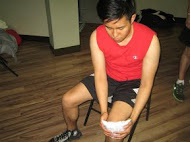Patellar tendinitis is a condition that involves the tendon that connects the kneecap or patella to the shinbone. The patellar tendon aids the muscles in extending the knees in kicking a ball, run uphill and jumping.
Athletes who play sports that require frequent jumping like basketball and volleyball are most susceptible to this condition. This is why patellar tendinitis is also known as jumper’s knee but people who do not participate in jumping sports can also experience patellar tendinitis. Patellar tendinitis can be treated with physical therapy to stretch and strengthen the muscles found around the knee. By enrolling in a class on first aid, you can easily manage this condition.
Symptoms of patellar tendinitis
Pain is the initial indication of patellar tendinitis. The pain can be felt in the patellar tendon found between the kneecap which is the patella and the area where the tendon attaches to the shinbone. The knee symptoms including the following:
- Pain can happen when starting a physical activity or doing an intense workout
- Pain becomes severe that it interrupts with sports activities
- It will interfere with daily tasks like climbing stairs or getting up from a chair.

The cause of patellar tendinitis is an overuse injury which happens when there is repeated stress on the patellar tendon. This stress will result to tiny tears in the tendon which the body will attempt to repair. If there are already plenty of tears in tendon, they will cause pain due to the inflammation and weakening of the structure of the tendon. If this tendon damage continues for more than a week, it is called tendinopathy.
Treatment and home remedies
- Take over-the-counter pain medications like ibuprofen and naproxen in order to minimize pain caused by patellar tendinitis.
- Avoid doing activities that causes pain on the knee by temporarily switching to a lower impact activity. Do not work through the pain since this will cause severe damage to the patellar tendon.
- Use knee brace or wraps to give extra support like when there is a need to be mobile
- Apply cold compress on the affected area in order to minimize pain and inflammation at least for 20 minutes every 3 to 4 hours. Ice will cause vasoconstriction or narrowing of the blood vessels which will minimize inflammation and pain by reducing the blood flow and lymph to the affected area.
- When the inflammation has subsided, apply warm compress to the affected area in order to promote blood flow to the knee.
- If overweight, reduce weight in order to lessen the inflammation and pain as well as take pressure off the knee. Eat a diet rich in a variety of fruits and vegetables that can provide the essential vitamins and minerals that are needed for healing such as vitamins C, A, E and calcium. Blending vegetables like carrots and cucumbers and drinking can give nutrients to the cells of the body.
- Massaging the tissues that surrounds the knee cap can be helpful in relieving tension and promotes circulation for patellar tendinitis.